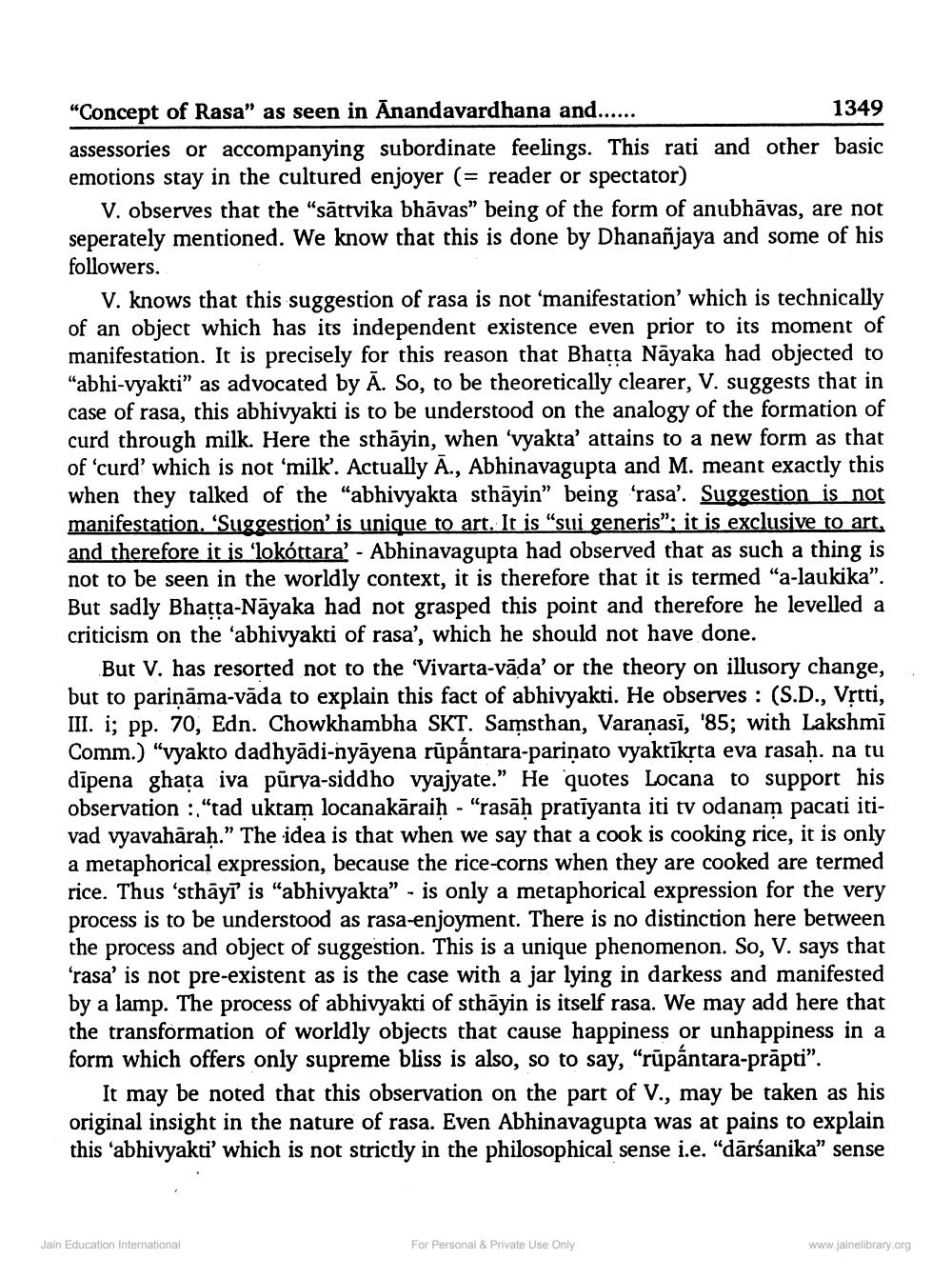________________
"Concept of Rasa" as seen in Anandavardhana and......
1349 assessories or accompanying subordinate feelings. This rati and other basic emotions stay in the cultured enjoyer (= reader or spectator)
V. observes that the "sātrvika bhāvas” being of the form of anubhāvas, are not seperately mentioned. We know that this is done by Dhanañjaya and some of his followers.
V. knows that this suggestion of rasa is not 'manifestation' which is technically of an object which has its independent existence even prior to its moment of manifestation. It is precisely for this reason that Bhatta Nayaka had objected to "abhi-vyakti” as advocated by Ā. So, to be theoretically clearer, V. suggests that in case of rasa, this abhivyakti is to be understood on the analogy of the formation of curd through milk. Here the sthāyin, when 'vyakta’ attains to a new form as that of 'curd which is not 'milk'. Actually A., Abhinavagupta and M. meant exactly this when they talked of the “abhivyakta sthāyin” being 'rasa'. Suggestion is not manifestation. 'Suggestion' is unique to art. It is "sui generis”; it is exclusive to art, and therefore it is 'lokóttara’ - Abhinavagupta had observed that as such a thing is not to be seen in the worldly context, it is therefore that it is termed “a-laukika”. But sadly Bhatta-Nayaka had not grasped this point and therefore he levelled a criticism on the 'abhivyakti of rasa', which he should not have done.
But V. has resorted not to the Vivarta-vāda' or the theory on illusory change, but to pariņāma-vāda to explain this fact of abhivyakti. He observes : (S.D., Vrtti, III. i; pp. 70, Edn. Chowkhambha SKT. Samsthan, Varanasī, '85; with Lakshmi Comm.) “vyakto dadhyādi-nyāyena rūpántara-pariņato vyaktīksta eva rasah. na tu dipena ghata iva pūrya-siddho vyajyate.” He quotes Locana to support his observation : “tad uktam locanakāraiḥ - "rasāḥ pratiyanta iti tv odanam pacati itivad vyavahāraḥ.” The idea is that when we say that a cook is cooking rice, it is only a metaphorical expression, because the rice-corns when they are cooked are termed rice. Thus 'sthāyī is "abhivyakta" - is only a metaphorical expression for the very process is to be understood as rasa-enjoyment. There is no distinction here between the process and object of suggestion. This is a unique phenomenon. So, V. says that 'rasa' is not pre-existent as is the case with a jar lying in darkess and manifested by a lamp. The process of abhivyakti of sthāyin is itself rasa. We may add here that the transformation of worldly objects that cause happiness or unhappiness in a form which offers only supreme bliss is also, so to say, “rūpántara-prāpti”.
It may be noted that this observation on the part of V., may be taken as his original insight in the nature of rasa. Even Abhinavagupta was at pains to explain this ‘abhivyakti' which is not strictly in the philosophical sense i.e. “dārśanika" sense
Jain Education International
For Personal & Private Use Only
www.jainelibrary.org




